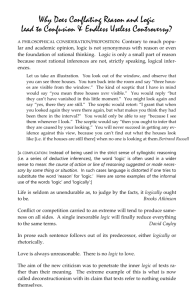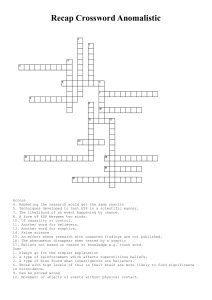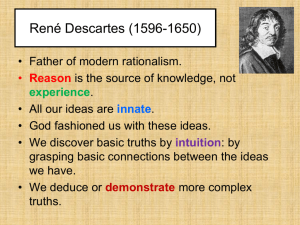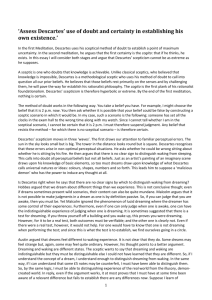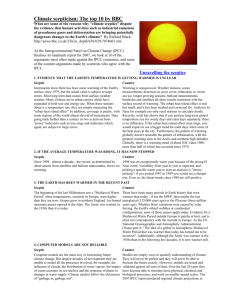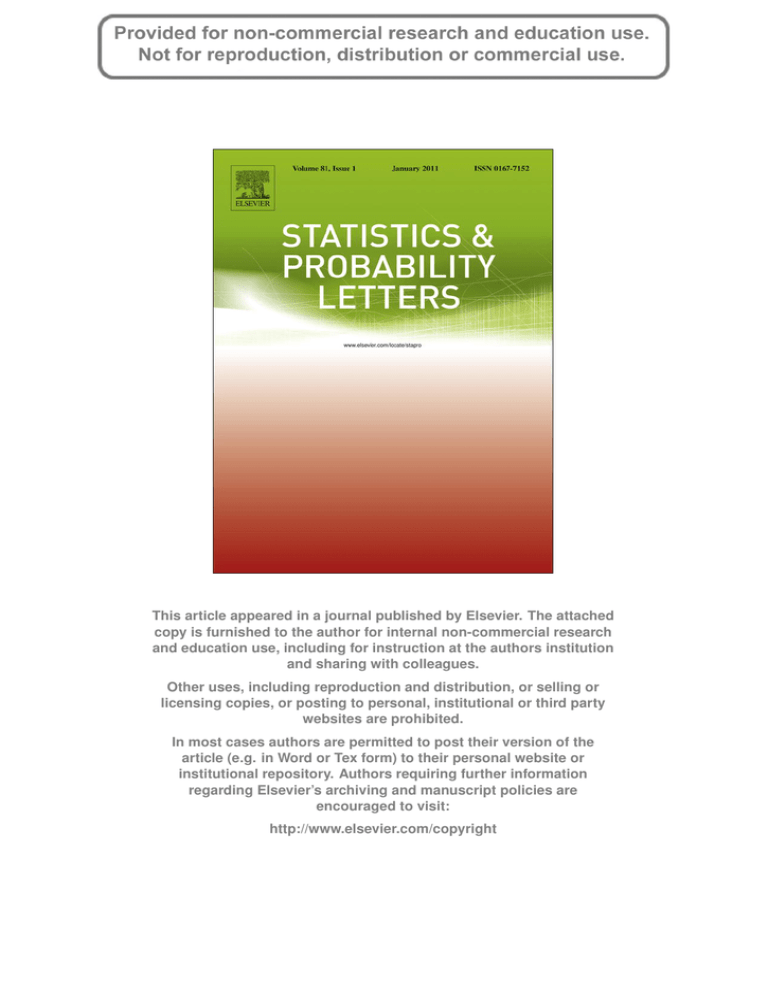
This article appeared in a journal published by Elsevier. The attached
copy is furnished to the author for internal non-commercial research
and education use, including for instruction at the authors institution
and sharing with colleagues.
Other uses, including reproduction and distribution, or selling or
licensing copies, or posting to personal, institutional or third party
websites are prohibited.
In most cases authors are permitted to post their version of the
article (e.g. in Word or Tex form) to their personal website or
institutional repository. Authors requiring further information
regarding Elsevier’s archiving and manuscript policies are
encouraged to visit:
http://www.elsevier.com/copyright
Author's personal copy
Statistics and Probability Letters 81 (2011) 157–162
Contents lists available at ScienceDirect
Statistics and Probability Letters
journal homepage: www.elsevier.com/locate/stapro
Insuring against loss of evidence in game-theoretic probability
A. Philip Dawid a , Steven de Rooij a,b , Glenn Shafer c,d , Alexander Shen e ,
Nikolai Vereshchagin f , Vladimir Vovk d,∗
a
Statistical Laboratory, Centre for Mathematical Sciences, University of Cambridge, UK
b
Centrum Wiskunde & Informatica, Amsterdam, Netherlands
c
Rutgers Business School, Newark, NJ, USA
d
Department of Computer Science, Royal Holloway, University of London, Egham, Surrey, UK
e
Laboratoire d’Informatique Fondamentale, CNRS, Marseille, France
f
Department of Mathematical Logic and the Theory of Algorithms, Moscow State University, Moscow, Russia
article
info
Article history:
Received 11 May 2010
Received in revised form 7 October 2010
Accepted 17 October 2010
Available online 30 October 2010
Keywords:
Evidence
Game-theoretic probability
Martingales
Mathematical finance
abstract
Statistical testing can be framed as a repetitive game between two players, Forecaster
and Sceptic. In each round, Forecaster sets prices for various gambles, and Sceptic chooses
which gambles to make. If Sceptic multiplies by a large factor the capital he puts at risk, he
has evidence against Forecaster’s ability. His capital at the end of each round is a measure
of his evidence against Forecaster so far. This can go up and then back down. If you report
the maximum so far instead of the current value, you are exaggerating the evidence against
Forecaster. In this article, we show how to remove the exaggeration. Removing it means
systematically reducing the maximum in such a way that a rival to Sceptic can always play
so as to obtain current evidence as good as Sceptic’s reduced maximum. We characterize
the functions that can achieve such reductions. Because these functions may impose only
modest reductions, we think of our result as a method of insuring against loss of evidence.
In the context of an actual market, it is a method of insuring against the loss of what an
investor has gained so far.
© 2010 Elsevier B.V. All rights reserved.
1. Introduction
In game-theoretic probability (see, e.g., Shafer and Vovk, 2001) Sceptic tries to prove Forecaster wrong by gambling
against him: the values of Sceptic’s capital Kn measure the changing evidence against Forecaster. We assume that Sceptic’s
initial capital is K0 = 1, and that Sceptic is required to ensure that Kn ≥ 0 at each time n.
Sceptic can lose as well as gain evidence. At a time n when Kn is large Forecaster’s performance looks poor, but then Ki
for some later time i may be lower and make Forecaster look better. Our result will show that, for a modest cost, Sceptic can
avoid losing too much evidence.
Suppose we exaggerate the evidence against Forecaster by considering not the current value Kn of Sceptic’s capital but
the greatest value so far:
Kn∗ := max Ki .
i ≤n
∗
Corresponding author. Tel.: +44 1784 443426; fax: +44 1784 439786.
E-mail address: vovk@cs.rhul.ac.uk (V. Vovk).
0167-7152/$ – see front matter © 2010 Elsevier B.V. All rights reserved.
doi:10.1016/j.spl.2010.10.013
Author's personal copy
158
A.P. Dawid et al. / Statistics and Probability Letters 81 (2011) 157–162
Continuing research started in Shafer et al. (2010a), we show that there are many functions F : [1, ∞) → [0, ∞) such that:
1. F (y) → ∞ as y → ∞ almost as fast as y, and
2. Sceptic’s moves can be modified on-line in such a way that the modified moves lead to capital
Kn′ ≥ F (Kn∗ ),
n = 1, 2, . . . .
(1)
If we are dissatisfied by the asymptotic character of the first of these two conditions, which does not prevent Kn′ /Kn from
becoming very small for some n, we can compromise by putting a fraction c of the initial capital on Sceptic’s original moves
and the remaining fraction 1 − c on the modified moves, thus obtaining capital c Kn + (1 − c )Kn′ at each time n. This way
Sceptic may sacrifice a fraction 1 − c of his capital but gets extra insurance against losing evidence. See Section 3 for details.
As we will show, the set of nondecreasing functions F for which (1) can be achieved can be characterized very simply: it
is the set of all nondecreasing F that satisfy
∞
∫
1
F (y)
y2
dy ≤ 1.
(2)
Similar results hold in measure-theoretic probability. One similar measure-theoretic result, for the case where Sceptic’s
strategy is known in advance, is proven in Shafer et al. (2010a) using a simple method based on Lévy’s zero-one law. Lévy’s
zero-one law generalizes to game-theoretic probability (see Shafer et al., 2010b), but in the present article, where Sceptic’s
strategy is not necessarily known in advance and Sceptic’s moves must be modified on-line, we use an entirely different
method of proof, based on the idea of stopping and combining capital processes. This idea has been used previously by
various authors, e.g., El-Yaniv et al. (2001, Theorem 1, based on Leonid Levin’s personal communication) and Shafer and
Vovk (2001, Lemma 3.1). We show that it gives optimal results in the setting of this article.
In Section 4 we explain the meaning of our results in the case where Sceptic represents someone actually trying to make
money, not a method for testing forecasts. Suppose Sceptic is a gambler (or an investor) who comes to a casino (stock market) with initial capital 1. In each round, we are allowed to observe how she gambles and then gamble on the same outcome,
before observing it, and we want to do so in such a way that our capital will always be at least F (K ∗ ), where F is a fixed nondecreasing function and K ∗ is her maximal capital so far. For which functions F can our goal be achieved? For F satisfying (2).
Alternatively, suppose we have some commodity, such as gold, that we want to sell within a fixed period, say a year. We
would like to sell it at the point in time during the year when its price is highest, but of course we never know whether the
current price will be exceeded later. If F satisfies (2), we have a strategy that guarantees the price F (K ∗ ), where K ∗ is the
highest price over the year. This provides an imperfect alternative to buying a floating lookback put option (see, e.g., Hull,
2009, Section 24.8); we get less protection, but we get it for free.
The main idea of the proof can also be explained in these terms. For every threshold u we consider the strategy that stops
playing when the current capital reaches (or exceeds) u. This corresponds to the function Fu (y) := u I{y≥u} . (If E is some
property, I{E } is defined to be 1 if E is satisfied and 0 if not.) Now we can mix these strategies according to some probability
measure P on u. It remains
y to notice that every nondecreasing function F satisfying (2) can be represented as such a mixture:
F (y) = Fu (y)P (du) = 1 uP (du).
In this article, we use the standard notation R for the set of real numbers; the set of natural numbers is N := {1, 2, . . .}.
The extended real line [−∞, ∞] is denoted R, and we use the convention ∞ + (−∞) := ∞.
2. Calibrating exaggerated evidence
Our prediction protocol involves four players: Forecaster, Sceptic, Rival Sceptic, and Reality.
Protocol 1 Competitive scepticism
K0 := 1 and K0′ := 1
for n = 1, 2, . . . do
Forecaster announces En ∈ E
Sceptic announces fn ∈ [0, ∞]X such that En (fn ) ≤ Kn−1
Rival Sceptic announces fn′ ∈ [0, ∞]X such that En (fn′ ) ≤ Kn′ −1
Reality announces xn ∈ X
Kn := fn (xn ) and Kn′ := fn′ (xn )
end for
The parameter of the protocol is a set X, from which Reality chooses her moves; E is the set of all ‘‘outer probability
contents’’ on X (to be defined shortly). We always assume that X contains at least two distinct elements. The reader who
is interested neither in
the most general statement of our result nor in Section 4 can interpret E as the set of all expectation
functionals E : f → f dP , P being a probability measure on a fixed σ -algebra on X; in this case Sceptic and Rival Sceptic
are required to output functions that are measurable w.r. to that σ -algebra.
Author's personal copy
A.P. Dawid et al. / Statistics and Probability Letters 81 (2011) 157–162
X
In general, an outer probability content on X is a function E : R
that satisfies the following four axioms:
1.
2.
3.
4.
159
X
→ R (where R is the set of all functions f : X → R)
X
If f , g ∈ R and f ≤ g, then E (f ) ≤ E (g ).
X
If f ∈ R and c ∈ (0, ∞), then E (cf ) = c E (f ).
X
If f , g ∈ R , then E (f + g ) ≤ E (f ) + E (g ).
X
For each c ∈ R, E (c ) = c, where the c in parentheses is the function in R that is identically equal to c.
An axiom of σ -subadditivity on [0, ∞]X is sometimes added to this list, but we do not need it in this article. (And it is
surprising how rarely it is needed in general: see, e.g., Shafer et al., 2010b.) In our terminology we follow Hoffmann-Jørgensen
(1987) and Shafer et al. (2010b). Upper previsions studied in the theory of imprecise probabilities (see, e.g., de Cooman and
Hermans, 2008) are closely related to (but somewhat more restrictive than) outer probability contents.
Protocol 1 describes a perfect-information game in which Sceptic tries to discredit the outer probability contents En
issued by Forecaster as a faithful description of Reality’s xn ∈ X. The players make their moves sequentially in the indicated
order. In each round Sceptic and Rival Sceptic choose gambles fn and fn′ on how xn is going to come out, and their resulting
capitals are Kn and Kn′ , respectively. Discarding capital is allowed, but Sceptic and Rival Sceptic are required to ensure that
Kn ≥ 0 and Kn′ ≥ 0, respectively; this is achieved by requiring that fn and fn′ should be nonnegative.
Let us call a nondecreasing function F : [1, ∞) → [0, ∞) a capital calibrator if there exists a strategy for Rival Sceptic
that guarantees (1) with F (∞) understood to be limy→∞ F (y). We say that a capital calibrator F dominates a capital calibrator
G if F (y) ≥ G(y) for all y ∈ [1, ∞). We say that F strictly dominates G if F dominates G and F (y) > G(y) for some y ∈ [1, ∞).
A capital calibrator is admissible if it is not strictly dominated by any other capital calibrator.
Theorem 1. 1. A nondecreasing function F : [1, ∞) → [0, ∞) is a capital calibrator if and only if it satisfies (2).
2. Any capital calibrator is dominated by an admissible capital calibrator.
3. A capital calibrator is admissible if and only if it is right-continuous and
∞
∫
F (y)
y2
1
dy = 1.
(3)
Proof. First we prove that any nondecreasing function F : [1, ∞) → [0, ∞) satisfying
F (y) =
∫
[1,y]
uP (du),
∀y ∈ [1, ∞),
(4)
for a probability measure P on [1, ∞) is a capital calibrator. For each u ≥ 1, define the following strategy for Rival Sceptic:
in round n, the strategy outputs
(u)
fn
fn
u
:=
if Kn∗−1 < u
otherwise
(u)
(u)
as Rival Sceptic’s move fn′ . Let us check that this is a valid strategy, i.e., that En (fn ) ≤ Kn−1 , n ∈ N, where K (u) is defined
(u)
(u)
(u)
by K0 := 1 and Kn := fn (xn ) for n ∈ N. There are three cases to consider:
(u)
(u)
(u)
1. If Kn∗−1 < u, we have Kn−1 = Kn−1 and En (fn ) = En (fn ) ≤ Kn−1 = Kn−1 .
(u)
(u)
(u)
2. If n is the smallest number for which Kn∗−1 ≥ u, we have Kn−1 = Kn−1 ≥ u and En (fn ) = En (u) = u ≤ Kn−1 .
(u)
(u)
(u)
3. Otherwise, we have Kn−1 = u and so En (fn ) = En (u) = u = Kn−1 .
(u)
(u)
Set fn′ (x) := [1,∞) fn (x)P (du), x ∈ X; this gives Kn′ = [1,∞) Kn P (du) when we set x to xn . Let us check that this is a valid
strategy for Rival Sceptic, i.e., that En (fn′ ) ≤ Kn′ −1 for all n ∈ N. This is now obvious if En are expectation functionals, and in
general we have
En (fn′ ) = En
∫
[1,∞)
∫
= En
I{K ∗ <u} fn + I{K ∗ ≥u} u P (du)
n−1
n−1
∫
[1,∞)
fn(u) P (du)
= En P ((Kn∗−1 , ∞))fn +
≤ P ((Kn∗−1 , ∞))Kn−1 +
[1,Kn∗−1 ]
∫
[1,Kn∗−1 ]
uP (du)
uP (du)
Author's personal copy
160
A.P. Dawid et al. / Statistics and Probability Letters 81 (2011) 157–162
∫
Kn−1 P (du) +
=
(Kn∗−1 ,∞)
∫
(u)
Kn−1 P (du)
≤
(Kn∗−1 ,∞)
∫
∫
(Kn∗−2 ,Kn∗−1 ]
∫
+
(Kn∗−2 ,Kn∗−1 ]
uP (du) +
∫
[1,Kn∗−2 ]
(u)
Kn−1 P (du)
uP (du)
∫
(u)
+
[1,Kn∗−2 ]
Kn−1 P (du)
(u)
=
[1,∞)
Kn−1 P (du) = Kn′ −1 .
The last inequality used the analysis of the three cases above. For small values of n, our convention was K0∗ := 1 and
∗
K−
1 := 1. Notice that our argument only used axioms 2–4 for outer probability contents; no σ -subadditivity was required.
This strategy will guarantee
∫
Kn′ =
[1,∞)
∫
Kn(u) P (du) ≥
[1,K ∗ ]
Kn(u) P (du) ≥
n
∫
[1,Kn∗ ]
uP (du) = F (Kn∗ ).
(5)
We can now finish the proof of the statement ‘‘if’’ in part 1 of the theorem, which says that any nondecreasing function
F : [1, ∞) → [0, ∞) satisfying (2) is a capital calibrator. Without loss of generality we can assume that F is right-continuous
and that (3) holds. It remains to apply Lemma 1.
Let us now check that every capital calibrator satisfies (2). Suppose a capital calibrator F violates (2). We can decrease
F so that, for some a > 1 and N ∈ N, it is constant in each interval [an−1 , an ), n = 1, . . . , N, is zero in [aN , ∞), and still
1
violates (2). Of course, F is still a capital calibrator. The substitution x = 1/y shows that 0 F (1/x)dx > 1, which can be
rewritten as
F (1) 1 −
1
a
+ F (a)
1
−
a
1
a2
+ · · · + F (aN −1 )
1
aN − 1
−
1
aN
> 1.
(6)
Suppose, without loss of generality, that X ⊇ {0, 1}, and let Forecaster always choose
En (f ) :=
1
a
f (1) +
1−
1
a
f (0),
n ∈ N.
(7)
Let Sceptic play the strategy of always betting all his capital on 1: fn (1) := aKn−1 and fn (x) := 0 for x ̸= 1. Then KN∗ = an
where n is the number of 1s output by Reality before the first element different from 1 (except that n = N if Reality outputs
only 1s during the first N rounds). Backward induction shows that the initial capital K0′ required to ensure KN′ ≥ F (KN∗ )
must be at least
F (aN )
N
1
a
+ F (aN −1 )
+ · · · + F (a)
1
1−
a
N −1
1
1−
a
1
a
1
a
+ F (1) 1 −
1
+ F (aN −2 )
a
N −2
1
a
1−
1
a
> 1;
(8)
the inequality follows from (6), but we know that it is false as K0′ = 1.
We have proved part 1 of the theorem. Part 3 is now obvious, and part 2 follows from parts 1 and 3.
The following lemma was used in the proof of Theorem 1.
Lemma 1. A nondecreasing right-continuous function F : [1, ∞) → [0, ∞) satisfies (3) if and only if (4) holds for some
probability measure P on [1, ∞).
Proof. Let us first check that the existence of a probability measure P satisfying (4) implies (3). We have:
F (y)
∫
[1,∞)
y2
∫
∫
u
dy =
[1,∞)
[1,y]
y2
P (du)dy =
∫
∫
[1,∞)
[u,∞)
u
y2
dyP (du) =
∫
[1,∞)
P (du) = 1.
(9)
It remains to check that any nondecreasing right-continuous F : [1, ∞) → [0, ∞) satisfying (3) satisfies (4) for some
probability measure P on [1, ∞). Let Q be the measure on [1, ∞) (σ -finite but not necessarily a probability measure) with
distribution function F , in the sense that Q ([1, y]) = F (y) for all y ∈ [1, ∞). Set P (du) := (1/u)Q (du). We then have (4),
and the calculation (9) shows that the σ -finite measure P must be a probability measure (were it not, we would not have
an equality in (3)). According to (3), the function
F (y) := α y1−α
is an admissible capital calibrator for any α ∈ (0, 1).
(10)
Author's personal copy
A.P. Dawid et al. / Statistics and Probability Letters 81 (2011) 157–162
161
3. Insuring against loss of evidence
Condition (2) implies lim infy→∞ F (y)/y = 0. Therefore, as we mentioned in Section 1, Kn′ /Kn may be very small for
some n even if (1) holds, and we pointed out a simple way to use Theorem 1 for insuring against this possibility. The following
corollary says that it leads to an optimal result.
Corollary 1. Let c ≥ 0 and F : [1, ∞) → [0, ∞) be a nondecreasing function. Rival Sceptic has a strategy ensuring
Kn′ ≥ c Kn + F (Kn∗ )
(11)
if and only if c and F satisfy
∞
∫
F (y)
y2
1
dy ≤ 1 − c .
(12)
Proof. Suppose (12) is satisfied; in particular, c ∈ [0, 1). Using cfn +(1 − c )fn′ as Rival Sceptic’s strategy, where fn are Sceptic’s
1
moves and fn′ are Rival Sceptic’s moves guaranteeing Kn′ ≥ 1−
F (Kn∗ ) (cf. Theorem 1), we can see that Rival Sceptic can
c
guarantee (11).
Now suppose Rival Sceptic can ensure (11), but (12) is violated. As in the proof of Theorem 1, we can decrease F so that,
for some a > 1 and N ∈ N, it is constant in each interval [an−1 , an ), n = 1, . . . , N, is zero in [aN , ∞), and still violates (12).
Similarly to (6), we have
F (1) 1 −
1
a
+ F (a)
1
a
−
1
a2
+ · · · + F (a
N −1
)
1
aN − 1
−
1
aN
> 1 − c.
Suppose X ⊇ {0, 1} and define Forecaster’s and Sceptic’s strategies as before. Now backward induction shows that the
initial capital K0′ required to ensure KN′ ≥ c KN + F (KN∗ ) must be at least
ca
N
1
N
1
N −1
1
1
N −2
1
+ F (a )
+ F (a )
1−
+ F (a )
a
a
a
a
1
1
1
+ · · · + F (a)
1−
+ F (1) 1 −
> c + (1 − c ) = 1.
N
N
N −1
a
a
This contradicts K0′ = 1.
a
N −2
1−
1
a
a
According to (10) and (11), Rival Sceptic can guarantee
Kn′ ≥ c Kn + (1 − c )α(Kn∗ )1−α
(13)
for any constants c ∈ [0, 1] and α ∈ (0, 1).
Corollary 1 does not mean that (13) or, more generally, (11) cannot be improved; it only says that the improvement
will not be significant enough to decrease the coefficient in front of Kn . For example, if we do not discard the term
(u)
(K ∗ ,∞) Kn P (du) in (5), we will obtain
n
Kn′ ≥ P ((Kn∗ , ∞))Kn + F (Kn∗ ).
(14)
The coefficient P ((Kn , ∞)) in front of Kn tends to zero as Kn → ∞.
In particular, using (14) allows us to improve (13) to
∗
∗
Kn′ ≥ c Kn + (1 − c )(1 − α)(Kn∗ )−α Kn + (1 − c )α(Kn∗ )1−α .
4. Insuring against loss of money
In conclusion, we discuss an application of our results to finance. Consider a financial market in which K securities are
traded over successive periods. Recall that the return of a security during a trading period is the ratio
closing price − opening price
opening price
,
and let xkn be the kth security’s return in the nth trading period. For each period n, write xn for the vector (x1n , . . . , xKn ), which
is in X := [−1, ∞)K .
Now consider how an investor might invest in the market during period n. Write γnk for the amount of money invested
in security k during period n, and write γn for the vector (γn1 , . . . , γnK ). Under the simplifying assumption that the investor
Author's personal copy
162
A.P. Dawid et al. / Statistics and Probability Letters 81 (2011) 157–162
is allowed to go long or short by any amount, γn can be any vector in RK . If the investor chooses γn and the market chooses
xn , then the investor’s profit will be γn1 x1n + · · · + γnK xKn .
This simple model of a financial market can be embedded in Protocol 1 as follows. As we said, X := [−1, ∞)K . In each
round Forecaster chooses the same outer probability content En = E on X, which is defined by
E (f ) := inf K |∃γ ∈ RK ∀x ∈ X : K + γ 1 x1 + · · · + γ K xK ≥ f (x) .
We leave it to the reader to verify that this satisfies the axioms for an outer probability content. In the situation of Protocol
1, where the function f is nonnegative, the infimum does not change if we additionally require that γ 1 , . . . , γ K should be
nonnegative and sum to at most K , and, therefore, inf is attained and can be replaced with min.
Now Forecaster is a dummy player, Sceptic is an investor in the market, Rival Sceptic is another investor, who decides on
his own investment for each trading period after seeing Sceptic’s decision, and Reality is the market. The initial capital is 1
for both investors. Results of this article show that Rival Sceptic can modify Sceptic’s decisions in such a way that his capital
Kn′ never drops much below the maximal value Kn∗ achieved by Sceptic’s capital Ki so far. For example, for any constants
c ∈ [0, 1] and α ∈ (0, 1), Rival Sceptic can guarantee (13).
Corollary 2. Let F : [1, ∞) → [0, ∞) be a nondecreasing function. In the protocol of this section, Rival Sceptic has a strategy
ensuring (1) if and only if F satisfies (2). Let c ≥ 0. Rival Sceptic has a strategy ensuring (11) if and only if c and F satisfy (12).
Proof. We will only prove the first statement. As discussed, the part ‘‘if’’ is a special case of Theorem 1. The part ‘‘only
if’’ is proved using the same idea as before. Namely, suppose F violates (2). Let a > 1 and N ∈ N satisfy (6). We can
assume, without loss of generality, that Reality is restricted to choosing xn ∈ {u, d}, where u, d ∈ X are the vectors
u := (a − 1, 0, . . . , 0) and d := (−1, 0, . . . , 0). A simple calculation shows that, under this restriction,
E (f ) =
1
a
f ( u) +
1−
1
a
f (d)
(cf. (7)). Suppose Sceptic always chooses γn = (Kn−1 , 0, . . . , 0) (i.e., invests all his capital in the 1st security). As before,
backward induction gives (8), and we arrive at a contradiction. We can apply these ideas not only to securities but also to commodities or dynamic portfolios of securities. In particular,
our two stories at the end of Section 1 are special cases of the framework of this section corresponding to K = 1. (The case
of an arbitrary K is not really more general: as far as our results are concerned, it reduces to the case of K = 1, since our
argument is also applicable to Sceptic’s returns.)
Acknowledgements
We would like to thank Peter Grünwald for inspiring part of this work. Comments by a referee were very helpful; in
particular, they led to the addition of Section 4 and expansion of Section 1. We are grateful to the participants of the
discussion of our work on Alexei Savvateev’s blog (savvateev.livejournal.com/66517.html). This research has been supported
in part by ANR grant NAFIT ANR-08-EMER-008-01 and EPSRC grant EP/F002998/1.
References
de Cooman, G., Hermans, F., 2008. Imprecise probability trees: bridging two theories of imprecise probability. Artificial Intelligence 172, 1400–1427.
El-Yaniv, R., Fiat, A., Karp, R.M., Turpin, G., 2001. Optimal search and one-way trading online algorithms. Algorithmica 30, 101–139.
Hoffmann-Jørgensen, J., 1987. The general marginal problem. In: Kurepa, S., Kraljević, H., Butković, D. (Eds.), Functional Analysis II. In: Lecture Notes in
Mathematics, vol. 1242. Springer, Berlin, pp. 77–367.
Hull, J.C., 2009. Options, Futures, and Other Derivatives, 7th ed.. Pearson Prentice-Hall, Upper Saddle River, NJ.
Shafer, G., Shen, A., Vereshchagin, N., Vovk, V., 2010a. Test martingales, Bayes factors, and p-values. The game-theoretic probability and finance project.
Working Paper 33. http://probabilityandfinance.com.
Shafer, G., Vovk, V., 2001. Probability and Finance: It’s Only a Game! Wiley, New York.
Shafer, G., Vovk, V., Takemura, A., 2010b, Lévy’s zero-one law in game-theoretic probability. The game-theoretic probability and finance project. Working
Paper 29. http://probabilityandfinance.com.

